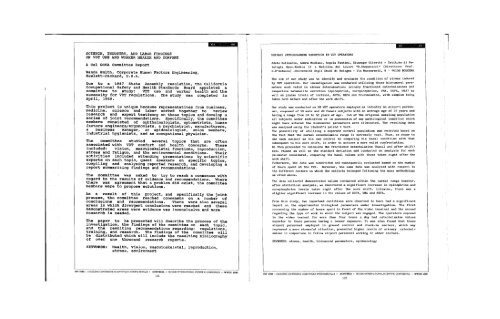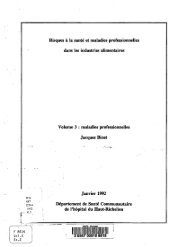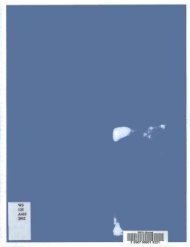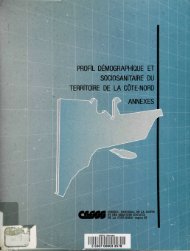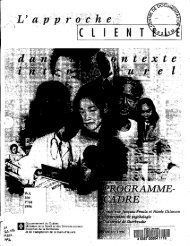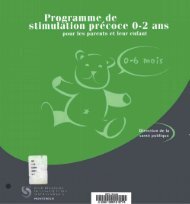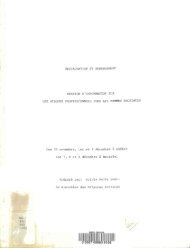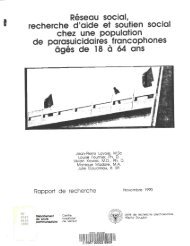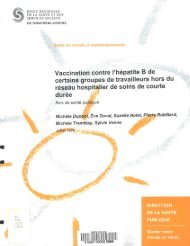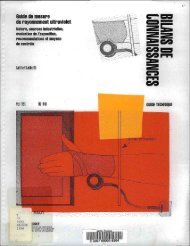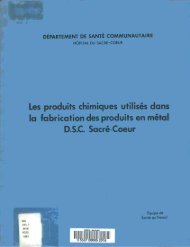le travail à l'écran de visualisation work with display units
le travail à l'écran de visualisation work with display units
le travail à l'écran de visualisation work with display units
You also want an ePaper? Increase the reach of your titles
YUMPU automatically turns print PDFs into web optimized ePapers that Google loves.
SCIENCE, INDUSTRY, AND LABOR FINDINGSON VDT USE AND WORKER HEALTH AND COMFORTA Cal OSHA Committee ReportWanda Smith, Corporate Human Factors Engineering,Hew<strong>le</strong>tt-Packard, U.S.A.Due to a 1987 state Assembly resolution, the CaliforniaOccupational Safety and Health Standards Board appointed acommittee to study: VDT use and <strong>work</strong>er health and thenecessity for VDT regulations. The study was comp<strong>le</strong>ted inApril, 1989.This project is unique because representatives from business,medicine, science and labor <strong>work</strong>ed together to reviewresearch and expert testimony on these topics and <strong>de</strong>velop aseries of joint recommendations. Specifically, the committeemembers consisted of ophthalmologists, optometrists, humanfactors engineers/ergonomists, a psychiatrist, manufacturers,a business manager, an epi<strong>de</strong>miologist, union members,industrial hygienists, and an occupational physician.The committee studied several topics that are oftenassociated <strong>with</strong> VDT comfort and health concerns. Theseinclu<strong>de</strong>d: vision, musculoske<strong>le</strong>tal functions, reproduction,stress and fatigue, and the environmental conditions. Theiractivities inclu<strong>de</strong>d attending presentations by scientificexperts on each topic, quest speakers on specific topics,compiling and analyzing reported research, and <strong>de</strong>veloping areport summarizing findings and recommendations.The committee was asked to try to reach a consensus <strong>with</strong>regard to the results of evi<strong>de</strong>nce and recommendations. Wherethere was agreement that a prob<strong>le</strong>m did exist, the committeemembers were to propose solutions.As a result of this project, and specifically the jointprocess, the committee reached consensus on a number ofconclusions and recommendations. There were also severalareas in which divergent conclusions were reached and these<strong>de</strong>monstrated areas were evi<strong>de</strong>nce was inconclusive and moreresearch is nee<strong>de</strong>d.The paper to be presented will <strong>de</strong>scribe the process of theinvestigation, the findings of the committee on each topic,and the resulting recommendations regarding: regulations,training, and research. The findings of the committee willbe distributed which will inclu<strong>de</strong> the resulting bibliographyof over one thousand research reports.KEYWORDS :Health, vision, musculoske<strong>le</strong>tal, reproduction,stress, environmentURINARY CATECHOLAMINE EXCRETION IN VDT OPERATORSA<strong>de</strong><strong>le</strong> Belisario, Ambra Modiano, Angela Fantini, Giuseppe Olivetti - Istituto di PatologiaSpec.Medica II e Medicina <strong>de</strong>l Lavoro "D.Campanacci" (Direttore: Prof.G.D 1 Antuono) -Université <strong>de</strong>gli Studi di Bologna - Via Massarenti, 9 - 40138 BOLOGNAThe aim of our study was to i<strong>de</strong>ntify and evaluate the condition of stress inducedby VDT operation. Our investigation was conducted utilizing those biohumoral parametersmost valid in stress <strong>de</strong>termination: urinary fractioned catecholamines andrespective metabolite excretion (epinephrine, norepinephrine, VMA, DOPA, HVA) aswell as plasma <strong>le</strong>vels of Cortisol, ACTH, NEFA and fructosamine, <strong>with</strong> samp<strong>le</strong>s beingtaken both before and after the <strong>work</strong> shift.Our study was conducted on 68 VDT operators employed as industry an airport personnel,coMposed of 19 ma<strong>le</strong> and 49 fema<strong>le</strong> subjects <strong>with</strong> an average age of 37 years andhaving a range from 24 to 52 years of age. Out of the original sampling populationall subjects un<strong>de</strong>r medication or in possession of any pathological condition whichmight have altered the biohumoral parameters were eliminated. The resulting datawas analyzed using the Stu<strong>de</strong>nt's paired t test.The possibility of utilizing a seperate control population was rejected based onthe fact that the normal catecholamine range is extremely vast. Thus, we chose touse each subject as his own control by comparing his basal condition <strong>with</strong> thatsubsequent to his <strong>work</strong> shift, in or<strong>de</strong>r to achieve a more valid confrontation.We then procee<strong>de</strong>d to calculate the fractioned catecholamine (basal and after shift)mea:i values as well as the standard <strong>de</strong>viation and conducted an analysis for eachparameter consi<strong>de</strong>red, comparing the basal values <strong>with</strong> those taken right after the<strong>work</strong> shift.Futhermore, the data was subdivi<strong>de</strong>d and subsequently evaluated based on the numberof hours spent at the VDT. Moreover, the same data was analyzed <strong>with</strong> respecb tothe different sectors in which the subjects belonged following the same methodologyas cited above.The data col<strong>le</strong>cted <strong>de</strong>monstrated values contained <strong>with</strong>in the normal range however,after statistical analysis, we discovered a significant increase in epinephrine andnorepinephrine <strong>le</strong>vels taken right after the <strong>work</strong> shift. Likewise, there was aslighter significant increase in the values of DOPA, VMA and NEFA.From this study, two important conditions were observed to have had a significantimpact on the experimental biological parameters un<strong>de</strong>r investigation. The firstconcerning the number of hours spent in front of the vi<strong>de</strong>o terminal and the secondregarding the type of <strong>work</strong> in which the subject was engaged. The operators exposedto the vi<strong>de</strong>o teminal for more than four hours a day had catecholamine valuessuperior to those persons having a <strong>le</strong>sser exposure. It was also found that thoseairport personnel employed in ground control and check-in sectors, which mayrepresent a more stressful situation, presented higher <strong>le</strong>vels of urinary catecholaminesin comparison to fellow airport personnel <strong>work</strong>ing in other sectors.KEYWORDS: stress, health, biohumoral parameters, epi<strong>de</strong>miologyTEV 1989 — DEUXIÈME CONFÉRENCE SCIENTIFIQUE INTERNATIONALE • MONTRÉAL • SECOND INTERNATIONAL SCIENTIFIC CONFERENCE — WWDU 1989TEV 1989 — DEUXIÈME CONFÉRENCE SCIENTIFIQUE INTERNATIONALE • MONTRÉAL • SECOND INTERNATIONAL SCIENTIFIC CONFERENCE — WWDU 1989125


